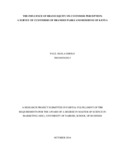| dc.description.abstract | In the 21st century, the priority for many firms has switched from acquiring customers and striving for customer loyalty to achieving strong brand equity. To compete in different product and service industries requires a customer driven strategy that is primarily founded on brand equity for its success. This study therefore investigates the influence of brand equity on customer perceptions of branded parks and reserves in Kenya. The study is focused on the influence of brand awareness, brand associations and proprietary assets on customer perceptions. The study is guided by a general objective that is; to find out the influence of brand equity on customer perceptions of branded parks and reserves in Kenya. To achieve this, the study looks into three specific objectives that are; to establish the influence of brand awareness on consumer perception, to establish the effect of brand associations on customer perceptions and to establish the influence of proprietary assets on customer perceptions of branded parks and reserves in Kenya. The target population of the study comprised visitors of branded parks and reserves in Kenya. Cluster sampling was adopted in the selection of parks and reserves with random sampling used to draw respondents from the clusters. Primary and secondary sources of data were utilized during the study, primary data was obtained through questionnaires distributed to the respondents in the field and collected upon successful completion. Secondary sources of data were derived from published literature from the World Bank, World Tourism organization (WTO) reports and Government of Kenya (GoK) tourism sector publications depicting growth of tourism industry, establishment of protected areas, wildlife conservation and marketing of tourism products and services in Kenya. Other sources of secondary data used include published books and journals of brand equity and Customer perceptions. The study applied qualitative methods of data analysis by use of descriptive statistics drawn from inferences made from graphs and tables generated from the raw data, cross tabulations were used to describe several variables simultaneously while correlation was conducted to relate the different brand equity variables. To process and analyze data, the Statistical Package for Social Sciences (SPSS) version 19 and Microsoft Excel 2010. The study showed that there is a positive influence of brand awareness, brand associations and proprietary assets on customer perceptions of branded parks and reserves in Kenya. Furthermore the study showed that brand awareness was the main driver of perceptions which should be built on by Destination Marketing Organizations (DMO) to influence positive customer perceptions. The study recommends that for service markets, strategies leading to brand awareness should be emphasized and more so in the tourism industry of Kenya. | en_US |



